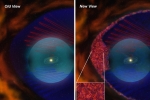Is Graphene The New Silicon? Innovative Electronic Device May Be Possible Due To Carbon-Based Material's Unique Properties

Scientists have been attempting to create graphene-based electronic devices for nearly a decade. That's because graphene has the unique ability to carry electrons seamlessly without any resistance at room temperature. This property is known as ballistic transport.
According to a new study in the journal Nature, graphene nanoribbons act like optical wave guides, or quantum dots, which allow the electrons to flow smoothly along the edges of the material. In contrast, other conductors like copper create considerable resistance as electrons move through the length of the conductor encountering more and more impurities.
Like Us on Facebook
The scientist measured the ballistic transport properties in 40 nanometers-wide graphene nanoribbons grown on the edges of three dimensional structures embedded into silicon carbide wafers. The ballistic transport properties studied in cylindrical carbon nanotubes exceeded conductance predictions in graphene by a factor of 10.
"This work shows that we can control graphene electrons in very different ways because the properties are really exceptional," said Walt de Heer, a Regent's professor in the School of Physics at the Georgia Institute of Technology. This finding will pave the way for the manufacture of a new class of electronic devices very different from silicon based devices, according to Heer.
Past efforts in the creation of grapheme-based devices have been pretty unsuccessful, because the material cannot be given the required bandgap to allow such devices to operate. If scientists can make a lattice of carbon atoms as little as a layer thick, it would then be possible to create such devices. Therefore, De Heer argues that scientists should stop focusing on using graphene like silicon, and focus instead on making use of the unique electron transport properties to create these devices. The new approach to switching will make ultrafast computing possible, because graphene nanoribbons will allow tens of hundreds of microns move seamlessly without scattering.
"It seems that the current is primarily flowing on the edges," de Heer said. "There are other electrons in the bulk portion of the nanoribbons, but they do not interact with the electrons flowing at the edges."
The scientist grew nanoribbons epitaxially on silicon carbon wafers. The used standard microelectronics fabrication techniques to etch patterns on them before heating the wafers to nearly 1000 degrees Celsius that drove silicon off along the edges. The process created perfectly smooth edges that allow the unrestricted flow of electrons. The traditional etching technique, on the other hand, results in rough edges — which makes ballistic transport impossible.
The electronic transport in the graphene nanoribbons could be similar to what is found in super conductors, according to De Heer. "There is a lot of fundamental physics that needs to be done to understand what we are seeing," he said. "We believe this shows that there is a real possibility for a new type of graphene based electronics."
The research involved a collaboration of scientists from Georgia Tech in the United States, Leibniz Universität Hannover in Germany, the Centre National de la Recherche Scientifique (CNRS) in France and Oak Ridge National Laboratory in the United States. It was supported by the Air Force Office of Scientific Research and the W.M. Keck Foundation.
© 2012 iScience Times All rights reserved. Do not reproduce without permission.

25 Year Study Reveals Eco-Farming To Be Economically Feasible And Sustainable

How Methane-Producing Microbes Caused The Largest Mass Extinction The World Has Ever Seen

Terrifying Animatronic Robot Dances To 'Blurred Lines,' Causes Nightmares [VIDEO]

Scientists Demonstrate Three-Way Quantum Communication: What's Faster Than The Speed Of Light?

Woolly Mammoth DNA To Be Cloned, Then Joined With Elephant DNA To Create New Creature

Oculus Rift Headset Will Take You On A Trip To Space, All From The Comfort Of Your Couch



![How to Turn Your Tap Water Faucet Into a Coffee Spout [VIDEO]](../../../cdn-sub/data/thumb/mainpage/6005-150100-coffee.jpg)

